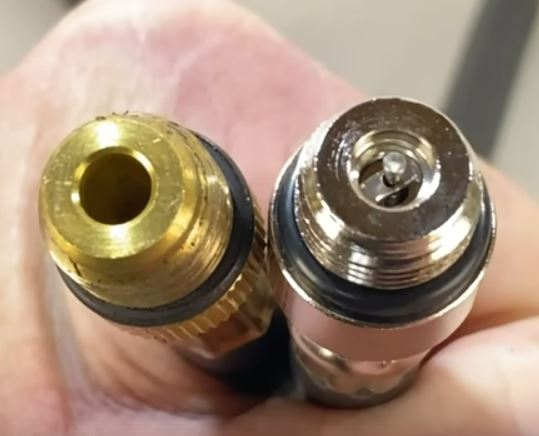Home › Forum › Ask A Member › 1956 Johnson 10hp. QD – 17 Compression
- This topic has 8 replies, 7 voices, and was last updated 4 months, 2 weeks ago by
 Waunnaboat.
Waunnaboat.
-
AuthorPosts
-
July 29, 2025 at 12:21 pm #298617
I have completely gone thru this motor , rebuild.
Cylinder. walls are like glass , new rings , new gaskets , converted to single line fuel system.
Yet I can only measure 55lbs. of compression with a Amazon compression gauge are there other types of gauges for these motors ? Pull start is pretty strong , hard.
I have no idea where I’m losing compression ?
I have a video of this motor running like a top , if I could get it to download.
I am wanting to sell this motor but cannot with this type of compression.
Any help would be greatly appreciated ! Thank you , D
July 29, 2025 at 3:41 pm #298623Maybe it just needs to break in a little?
The easiest way to have confidence in a new compression gauge is to compare it with a “known good” gauge. Maybe a friend has one?
I see posts all the time about incorrect readings from the typical Harbor Freight gauges. The other thing to be aware of is the location of the valve. For small displacement engines it is better (more accurate) to select a gauge with the valve right at the motor end of the hose. Reason being is that you do not have the extra volume of the hose to fill; adding to the displacement of the cylinder if you will…..
1 user thanked author for this post.
July 29, 2025 at 3:48 pm #298625Maybe it just needs to break in a little?
The easiest way to have confidence in a new compression gauge is to compare it with a “known good” gauge. Maybe a friend has one?
I see posts all the time about incorrect readings from the typical Harbor Freight gauges. The other thing to be aware of is the location of the valve. For small displacement engines it is better (more accurate) to select a gauge with the valve right at the motor end of the hose. Reason being is that you do not have the extra volume of the hose to fill; adding to the displacement of the cylinder if you will…..
Thank you , Seakaye….It runs so good.
I’ll check those tips out.
July 29, 2025 at 4:01 pm #298626Maybe it just needs to break in a little?
The easiest way to have confidence in a new compression gauge is to compare it with a “known good” gauge. Maybe a friend has one?
I see posts all the time about incorrect readings from the typical Harbor Freight gauges. The other thing to be aware of is the location of the valve. For small displacement engines it is better (more accurate) to select a gauge with the valve right at the motor end of the hose. Reason being is that you do not have the extra volume of the hose to fill; adding to the displacement of the cylinder if you will…..
Thank you , Seakaye….It runs so good.
I’ll check those tips out.
I just watched a video on compression testers with a Schrader Valve and I’m sure that’s exactly my problem.
I’m using an automotive compression tester !
Thank you very much !
July 29, 2025 at 5:29 pm #298629If it’s currently running good, compression isn’t your problem,
but it would be nice to have an accurate gauge!Prepare to be boarded!
July 29, 2025 at 7:48 pm #298633Just demonstrate it running and don’t mention compression. Nobody I’ve sold or given motors to has asked about compression. If someone asks, just say you don’t know but have them pull it over to see there is a good, hard, compression feel.
I got a compression gauge at a NAPA auto parts store with the valve at the motor end like others mentioned. I had an old Sears one made for cars with the valve at the gauge and it gave me a lot of low readings. On big cylinders in cars, the Sears one worked OK.
Dave
July 29, 2025 at 8:49 pm #298636if it runs good don`t fix it
Joining AOMCI has priviledges 🙂
August 1, 2025 at 1:59 pm #298707If it’s running and idles well, you don’t have a compression problem, you have a gauge problem.
August 1, 2025 at 4:22 pm #298710I would go with the rule of if it runs, it has fine compression. I believe that the concern for compression in multiple cylinder engines of any type is that 1: they have different amounts of compression per cylinder , or 2: they have compression that is concerningly low or nonexistent.
"Outboards seem to multiply exponentially..........I find that for every finished project, there are two more waiting to be completed."
-
AuthorPosts
- You must be logged in to reply to this topic.


